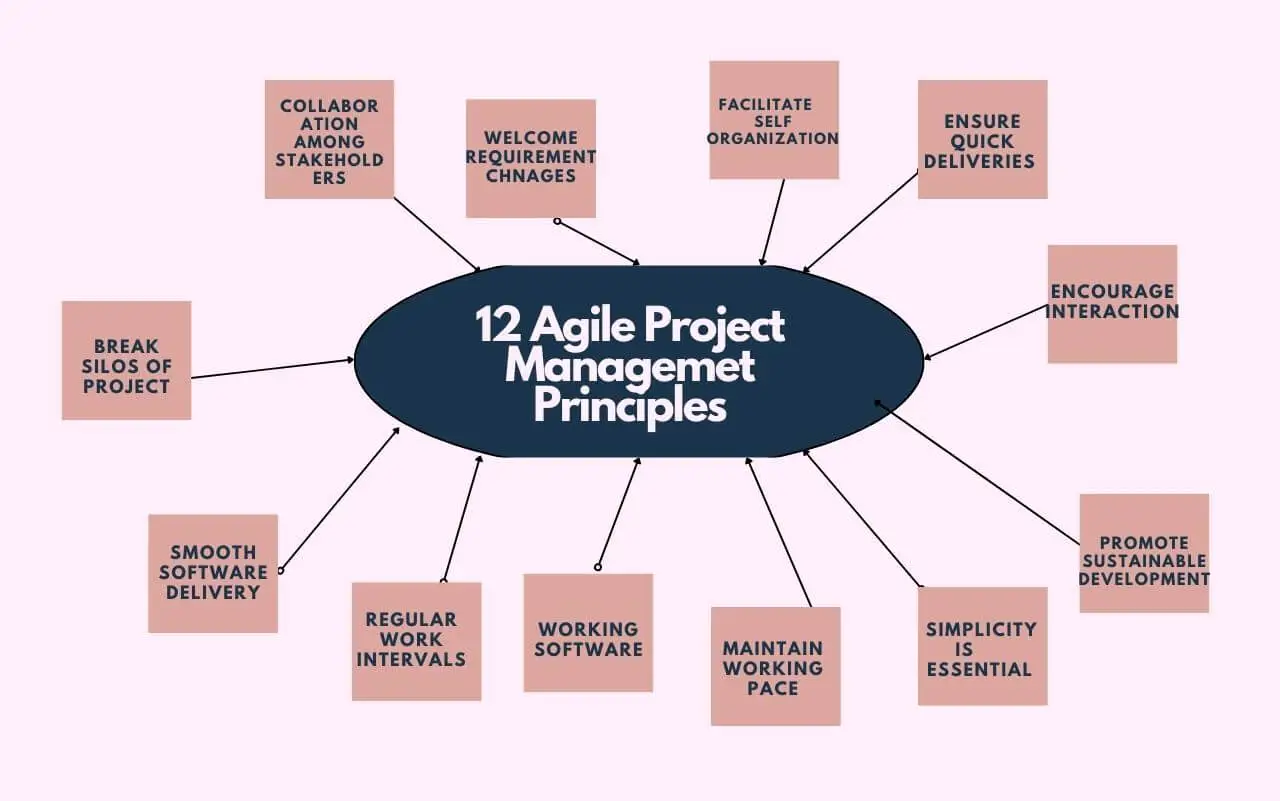It’s no secret that the Agile methodology quickly replaces other project management techniques. A report states that 35% of projects are not completed in the allotted time, 54% go over budget, and 31% don’t achieve the intended objectives and business intent. This sounds less than upbeat. The need for more flexible and evolutionary processes drives an increase in responses from teams, organizations, and even project management software; and all this with good cause. Agile project management principles and practices succeed in a company environment undergoing rapid change and must adapt to quick changes in the market and technology.

Table of Contents
What is Agile Project Management?
In agile project management, the goal is to produce outcomes to satisfy stakeholders’ needs. The term “Agile” refers to the fact that it was created for software development work. However, it applies to any project.
Agile working principles share many characteristics, including:
- Incremental delivery of products, services, and results
- Emphasis on adaptive planning, evolutionary development and delivery, and continuous improvement
- Highly collaborative team environment with a focus on co-location of team members
- Self-organizing teams who take responsibility for their work activities
Agile project management principles rely on frequent communication among team members and the customer. This reduces the number of surprises during the project because everyone is working towards the same goal.
→ Related content: What Is Agile Project Management And How To Apply This For Your Project?
12 Agile Project Management Principles
Here are Agile principles and practices you need to know:
Deliver Working Software Frequently
The most crucial thing in agile working principles is to deliver working software, not just “lots” of it. This means you should spend as much time as possible ensuring your code works before trying to add new features or improve performance.
Business People and Developers Must Work Together
Developing software requires cooperation between business people and developers. Each group has its unique perspective on what needs to be done. So, they need to share information regularly to work together more effectively. Also, make sure to look for agile product discovery phases.
→ Related content: Agile Product Discovery Phases
Working Software Is the Primary Measure of Progress
Working software often delivers Agile project management principles to users. Additionally, this contrasts with traditional approaches where non-working documents or blueprints define solutions. Using it in real time lets customers see whether or not the product works for them.
Have Regular Intervals
Agile teams plan their work in regular intervals, typically two-week sprints. During each break, the team plans what they will do and commits to delivering some “potentially shippable” product increment. The group holds itself accountable for its actions while ensuring they are ready to change course as needed.
Welcome Changing Requirements Even Late in the Project
Change is inevitable on projects, so don’t get stuck trying to plan everything upfront. Instead, embrace changes as they arise and adjust your plans accordingly. A good Agile team knows how to respond quickly when requirements change or new ideas emerge during development — because they’ve planned for these things from the beginning by breaking down work into small chunks that can be quickly reorganized when necessary.
Break the Silos of Your Project
Agile project management principles focus on cross-functional teams to facilitate communication among various project stakeholders.
You can substitute “engineers” or “designers” or another term that better fits your circumstance for the word “developers” in a knowledge work setting that isn’t directly tied to software development. The objective is to synchronize those who produce value with those who plan or sell it. You may enhance the performance of your processes and make internal cooperation seamless in this way.
Maintain a Sustainable Working Pace
Agile teams must maintain a sustainable pace to complete the work needed for each sprint. This is important because if the team works too fast, they will not be able to meet all of the planned tasks for that sprint and cannot finish their work on time. If the team works too slowly, it will take them longer than expected to complete the sprint, and they may miss deadlines.
Simplicity is Essential
Agile teams should strive for simplicity in everything they do. This means they should keep things as straightforward as possible while still accomplishing their goals. For example, an agile team could use a simple Kanban board instead of a complex JIRA board if it helps them complete their work more efficiently.
Agile Processes Promote Sustainable Development
Short activity sprints are beneficial since they make it easier for people to accept change and keep your teams motivated. Burnout will occur if you labor on a project for an extended time. Undoubtedly, it’s unavoidable. Don’t put too much overtime pressure on your team. It will affect how well your project turns out. Get the ideal crew for the job—one that will work hard without going above and above and jeopardizing the project’s quality.
→ Related content: Sprint Components – Improve Sprint Process with AgileBox
Encourage In-Person Interactions
Agile heavily incorporates the involvement of the customer in product development. Recording discussions, producing email narrative streams, or using collaboration tools is fine. You can also endeavor to maintain the timetables to make at least a video conference. This fosters a climate of collaboration.
Satisfy the Customer Through Early Delivery
You may concentrate on the project’s real purpose, which is to deliver what the customer wants, not what you intended, by reducing the time between documenting the project, reporting to your customer, and receiving feedback.
Self-organizing Teams Generate Most Value
Giving a solid team the freedom to make individual decisions is a good idea. As a result, they can adjust to change more quickly. Because you’ve given them the freedom to act without worrying about the consequences, they can do everything with more agility. Gathering the appropriate people would enable them to discuss and resolve issues before they become problems.
Final Words
Agile has become an umbrella term that covers anything new, calm, and trendy. Behind Agile lies a set of well-defined agile project management principles and values that are helpful in any industry or situation.
From planning to prioritizing your backlog, from setting your sprint goals to doing a retrospective, here’s what your team needs to stay effective. You know the obstacles to getting things done—but with Scrum Planning Poker, how long until you start taking down those barriers?
→ Manage your Agile project with ProductGo – Agile User Story Map, Portfolio Roadmaps & Persona for Jira













